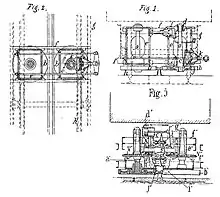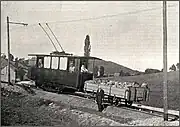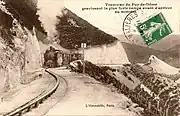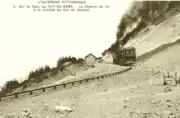The Hanscotte system was a design for railway locomotives and track using, in addition to the conventional load-bearing driving wheels, pairs of horizontal driving wheels mounted underneath the locomotive and pressing inwards upon a central rail, to improve adhesion and traction. The engineer Jules Hanscotte developed the system while working for Société de construction des Batignolles (SCB), Paris, in about 1904.
SCB intended to use the system for braking very heavy trains, but the most notable deployment was on the Chemin de Fer du Puy-de-Dôme, a tourist light railway between Clermont Ferrand and the summit of the Puy-de-Dôme, in 1906.
Development

In 1898 Hanscotte was working for the engineering company Société de Construction des Batignolles (SCB) (successor to Ernest Goüin et Cie., the company contracted to build Fell system centre-rail locomotives for the Mont Cenis Pass Railway in 1867). In 1904 he started work on a design for a similar system, which he perfected in 1906.[1] The main difference from John Fell's earlier system was that Hanscotte's horizontal wheels were held in place on the centre rail by compressed air pistons operating through levers, rather than steel springs, thus allowing more flexibility and placing less strain on the locomotive through imperfections in the track.[2] By placing the opposed pairs of horizontal wheels at the ends of the locomotive, rather than close together, Hanscotte ensured that they were less likely to drop contact at small gaps in the central rail and so fail to maintain traction—on the Chemin de Fer du Puy-de-Dôme line narrow gaps in the centre rail were permitted at level crossings.[3] Power transmission was through a chain drive and, in their first deployment in a transport application, André Citroën's chevron gears.[2] Three sets of brakes operated: on the vertical driving wheels; on the horizontal wheels; and directly onto the centre rail with a horizontally opposed pair of brake shoes.[2]
SCB's main interest was reliability in braking heavy trains and keeping vehicles on the track in mountainous routes prone to high winds; the company declined to extend development for traction on steep gradients.[1] However, Hanscotte's centre-rail brakes remained a feature of the company's designs for rail-mounted heavy artillery and support wagons.[1][4][5]
Chemin de Fer du Puy-de-Dôme
In 1904 the company Fives-Lille of Lille, northern France, took an interest in the Hanscotte system. Their first customer was the promoter Jean Claret, who bought a single electric tramcar and some other rolling stock for his short, steep line of the Tramway de La Bourboule,[6] which ran from the town centre of La Bourboule to the lower end of the Funiculaire de La Bourboule. The enterprise was successful, and Claret used Hanscotte-equipped Fives-Lille steam locomotives for his ambitious project of a tourist light railway from the centre of Clermont Ferrand to the summit of the spectacular Puy-de-Dôme. For the first 2.5 kilometres (1.6 miles) from the city centre as far as Les Quatre Routes, Chamalières, conventional two-rail track, (electrified in 1911) was used.[3][2][7]
The line never made money and it closed in 1925 because of competition from a new autobus route.[2]
Furka Oberalp Railway
In 1910 the Swiss Locomotive and Machine Works, Winterthur, prepared designs for Hanscotte system locomotives to operate the Furka Oberalp Railway, but the Swiss federal railway authority directed that the Abt system be used instead.[8]
Gallery
 The first commercial use of Hanscotte's system was on La Bourboule tramway of 1904
The first commercial use of Hanscotte's system was on La Bourboule tramway of 1904 Hanscotte locomotive (built by Fives-Lille) departing from lower terminus of Puy-de-Dôme railway, about 1907
Hanscotte locomotive (built by Fives-Lille) departing from lower terminus of Puy-de-Dôme railway, about 1907 Publicity poster for the Puy-de-Dôme railway, about 1910
Publicity poster for the Puy-de-Dôme railway, about 1910 Ascent of the Puy-de-Dôme, 1910, showing the central rail. Much of the track was laid alongside the road to the summit.
Ascent of the Puy-de-Dôme, 1910, showing the central rail. Much of the track was laid alongside the road to the summit. Steep section of the Puy-de-Dôme railway, 1910
Steep section of the Puy-de-Dôme railway, 1910 Hanscotte locomotive at summit of the Puy-de-Dôme railway, 1910
Hanscotte locomotive at summit of the Puy-de-Dôme railway, 1910
References
- 1 2 3 Burnel, Anne (1995). La société de construction des Batignolles de 1914 à 1939: histoire d'un déclin (in French). Geneva: Librairie Droz. pp. 127–128. ISBN 2-600-00094-1.
- 1 2 3 4 5 Lamming, Clive [in French] (11 November 2021). "De Fell à Hanscotte : l'adhérence pour les locomotives à fortes rampes". Retrieved 6 August 2023.
- 1 2 Bulletin of the International Railway Congress. Vol. XXII. London: P. S. King and Son. 1908. p. 696.
- ↑ "U.S. Patent Jules Etienne Hanscotte Brake Car". 16 December 1919. Retrieved 7 August 2023.
- ↑ Dantin, Charles (1920). "The use of the Hanscotte system for the haulage of artillery trains". Monthly Bulletin. Vol. 2. Brussels: International Railway Congress Association. p. 272.
- ↑ "Tramway électrique avec mécanisme d'adhérence à roues horizontales et rail central en service à La Bourboule". Le Génie civil : revue générale des industries françaises et étrangères (in French). 22 October 1904. p. 402.
- ↑ "Puy de Dôme et Chaîne des Puys: Création de la ligne de tramway de Clermont-Ferrand au sommet du puy de Dôme - 1907". volcan.puy-de-dome.fr (in French). Conseil départemental du Puy-de-Dôme.
le train du puy de Dôme a déjà une fonction touristique
- ↑ "The Furka Railway and Furka Tunnel". Engineering. No. 100. 5 November 1915. p. 475.